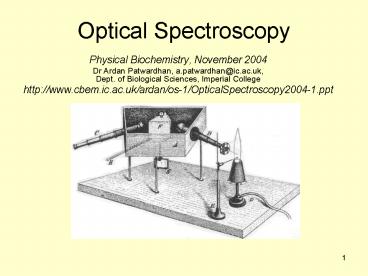Optical Spectroscopy - PowerPoint PPT Presentation
1 / 24
Title: Optical Spectroscopy
1
Optical Spectroscopy
- Physical Biochemistry, November 2004
- Dr Ardan Patwardhan, a.patwardhan_at_ic.ac.uk,Dept.
of Biological Sciences, Imperial College - http//www.cbem.ic.ac.uk/ardan/os-1/OpticalSpectro
scopy2004-1.ppt
2
Course Plan
- Absorbtion spectroscopy
- Circular dichroism
- Rotational and vibrational spectroscopy
- Fluorescence and phosphoresence
3
Absorption and emission spectra (atoms vs
molecules)
Atoms!
Molecules!
Atoms!
4
Complementary Colors
- The absorbed and perceived spectral band are
diametrically opposite each other in the color
wheel
5
Electronic (UV) spectroscopy
- Light absorbed electron excited to higher
molecular orbital
DEhn
6
Definitions etc
- Chromophores- Part of molecule responsible for
absorption - Auxochromes- Groups that modify absorption of
neighboring chromophores- Often have lone pairs,
e.g. OH, -OR, -NR2, -halogen- Bathochromic
shift towards longer wavelength- Hypsochromic
shift towards shorter wavelength- Hyperchromic
effect increase in peak absorbance- Hypochromic
effect decrease in peak absorbance - Typical for unconjugated organic molecules? ?
? below 150 nm (vacuum UV)n ? ?, ? ? ? below
200 nm (quartz UV)n ? ? 200-400nm (quartz UV)
7
Effect of conjugation
- Increased conjugation leads to longer absorption
wavelengths - Ex Butadiene absorbs at 217nm whereas lycopene
absorbs at 470nm
8
Polycyclic aromatic hydrocarbons
- Extensive conjugation leads to large bathochromic
shift
9
Auxochromes
- Auxochromes with lone pairs often lead to
increased delocalization (and conjugation) and
therefore a bathochromic shift
10
Solvent pH effect on phenol spectrum
- Increasing pH shifts equilibrium to right
- More non-bonding electrons in phenoxide ion ?
higher extinction coefficient ? greater
delocalization ? bathochromic shift(l,e)(270,145
0) (287,2600)
11
Solvent pH effect on aniline spectrum
- Decreasing pH shifts equilibrium to right
- No non-bonding electrons in anilinium ion ?
lower extinction coefficient ? less
delocalization ? hypsochromic shift(l,e)(280,143
0) (254,169)
12
Amino acids with significant absorbtion
13
Dependence of tyrosine spectrum on pH
- pH titration can be used to determine - whether
Tyr is internal or external- environment
14
Polarity effects of the solvent
- p more polar than p in polar molecules? p
better stabilized than p in polar solvent? p ?p
transition undergoes bathochromic shift with
increasing polarity of solvent - Hydrogen bonding stabilizes n more than p in
polar solvents ? n ?p undegoes hypsochromic
shift ?peak absorbance is reduced due to
stabilization of non-bonding electrons
15
Effect of solvent polarity on tyrosine spectrum
- Solid line solv water
- Dashed line 80 water and 20 ethylene glycol
16
Difference spectrum
- Perturbing solvent 80 water 20 substance of
reduced polarity (e.g. ethylene glycol) - DAAps Awater
- DA0 ? sample unaffected by perturbant
- Ex DA1 for free tryptophan but in a protein
with 5 Trp it is 0.6 when measured using eth.
gly. (4.3Å) and 0.4 when measured using
glycerol(5.2 Å)for eth gly (0.6/1) x 5 3 Trp
accessiblefor glycerol (0.4/1) x 5 2 Trp
accessible? 3 2 1 Trp lies in a crevice
which is between 4.3 Å and 5.2 Å in diameter
17
Linearly, circularly and elliptically polarised
light
18
Linear and elliptical from circular
- Combination of L and R circularly polarised
light- of equal amplitudes gives linearly
polarised light- of unequal amplitudes gives
elliptically polarised light
19
Optical activity
- Enantiomers are optically active
- Optically active molecules have different
refractive indices, and different extinction
coefficients for L and R circularly polarised
light
20
Optical rotatory dispersion (ORD)
- Measurement of rotation as a function of
wavelength - Refractive index is wavelength dependent
21
Circular dichroism (CD)
- Measurement of difference in extinction
coefficient for L and R as a function of
wavelength - Sign yields handedness information for absorbing
chiral centre - Easier to interpret than ORD
22
ORD versus CD
CD
ORD
23
Study of proteins with CD
- Peptide bond absorption (200nm) mainly studied
(asymmetry imposed by environment) - CD good for determining alpha helical content
- Excellent at monitoring conformational changes-
changes in enzyme structure upon binding-
protein denaturation- protein folding
24
Trends
- Shorter wavelengths
- Improved prediction software for proteins
- Better understanding of electronic transitions
involved































